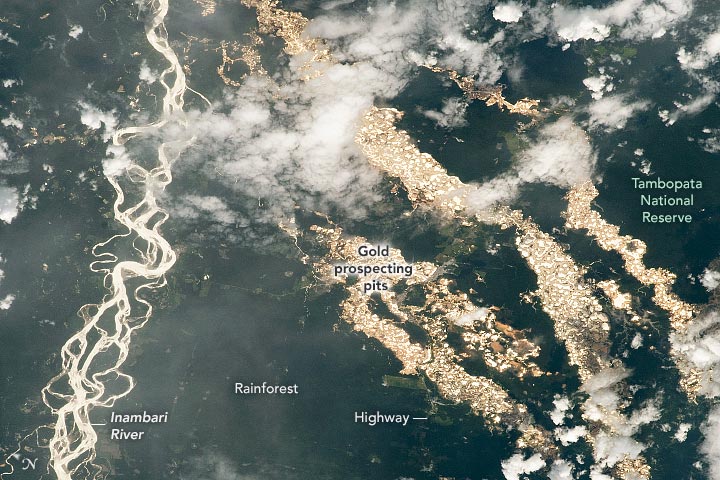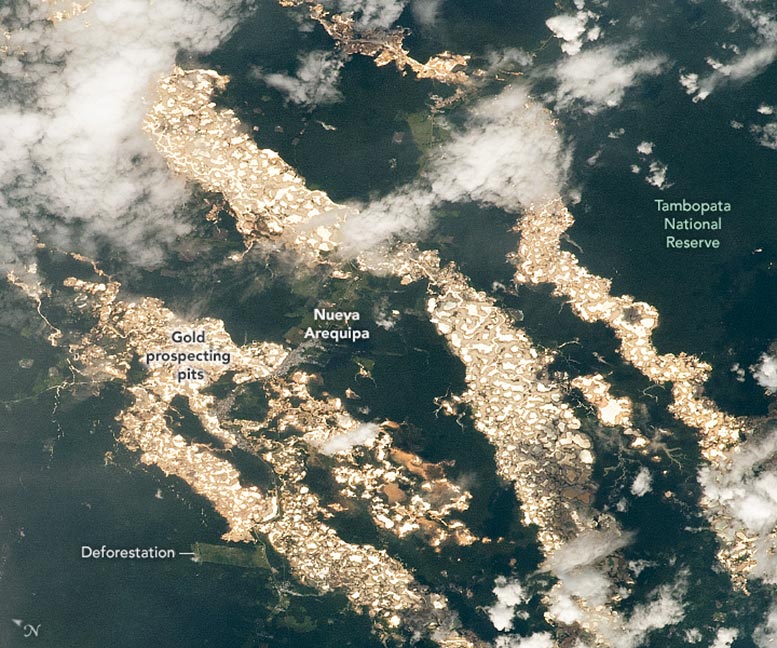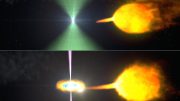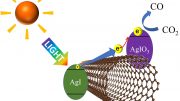An astronaut aboard the International Space Station (ISS) took this photograph of numerous gold prospecting pits in eastern Peru. The pits—usually hidden from an astronaut’s view by cloud cover or outside the Sun’s glint point—stand out brilliantly in this image due to the reflected sunlight. The multiple meandering channels of the Inambari River are visible on the left side of the image. The river and the pits cut through the otherwise unbroken Amazon rainforest in Peru’s Madre de Dios state.
In this very wet climate, the prospecting pits appear as hundreds of tightly packed water-filled basins. Likely dug by garimperos (independent miners), each pit is surrounded by de-vegetated areas of muddy spoil. These deforested tracts follow the courses of ancient rivers that deposited sediments, including gold. For scale, the western tract at image center is 15 kilometers (10 miles) long.
Peru is the sixth largest producer of gold in the world, and Madre de Dios is home to one of the largest independent gold mining industries in the world. Mining is the main cause of deforestation in the region, and it also can cause mercury pollution from the gold-extraction process. Yet tens of thousands of people earn their living from this unregistered mining.
The small town of Nueva Arequipa is just visible along the Southern Interoceanic Highway. Inaugurated in 2011, the highway, is the only road connection between Brazil and Peru. It was intended to stimulate trade and tourism, but due to the great expansion of surface prospecting, deforestation may be the larger result of the highway. Some areas in the state are protected from mining, such as the Tambopata National Reserve.
Astronaut photograph ISS064-E-16203 was acquired on December 24, 2020, with a Nikon D5 digital camera using a 400 millimeter lens and is provided by the ISS Crew Earth Observations Facility and the Earth Science and Remote Sensing Unit, Johnson Space Center. The image was taken by a member of the Expedition 64 crew. The image has been cropped and enhanced to improve contrast, and lens artifacts have been removed. The International Space Station Program supports the laboratory as part of the ISS National Lab to help astronauts take pictures of Earth that will be of the greatest value to scientists and the public, and to make those images freely available on the Internet. Additional images taken by astronauts and cosmonauts can be viewed at the NASA/JSC Gateway to Astronaut Photography of Earth. Caption by Justin Wilkinson, Texas State University, JETS Contract at NASA-JSC.











From a linked article: “Some march through Puerto Maldonado’s main plaza shouting through megaphones that mercury is killing everyone, whereas others are willing to drink the toxic liquid metal to prove it is safe.”
As is often the case, the truth lies somewhere in the middle. Liquid mercury will indeed pass through one’s gastrointestinal system with little absorption. However, mercury vapor causes neurological damage even in short doses of low concentration. The mercury miners in Spain, who breathed in vapors in underground tunnels, were retired by the mining company when they could no longer sign their checks.
Most fish carry some mercury, in the form of methyl mercury, even in areas that are not gold-mining sites. It tends to be most concentrated in fish at the top of the food chain. However, methyl mercury is quite volatile, having a boiling point the same as water. Cooking the fish releases most of the methyl mercury, which is why there has never been a well-documented case of methyl mercury poisoning in the USA, unlike in Japan where they commonly eat raw fish, sashimi. The elevated mercury levels in the miners and their family members is most likely the ubiquitous exposure to mercury vapors from all the miners releasing mercury into the air from ‘retorting’ their amalgam.
The tragedy is that the mercury really isn’t necessary to capture the coarse alluvial gold. The miners buy mercury and then poison themselves and their families. If they were educated in modern mining practices they would realize that. However, if they were educated, they wouldn’t need to be garimperos! It is a vicious circle!
I knew a gold miner who poisoned himself with his careless handling of his mercury coated gold. This took place in the Sierras. For some reason he had taken to cleaning his gold inside of his travel trailer in which he would spend the summer in while prospecting. He worked the local creeks and mossed stream banks. He must have been around 50 years of age when I first met him, but by appearance he looked more like 70. Even when I first met him his pale pallor caught my eye.
The mercury was obviously starting to affect him. He had become suspicious of others. It was surprising that this man seemed to be unaware of what everyone else knew about the dangers of mercury. Yet every day at the end of the day he took his gold inside to cook off the mercury. This was in 1982. When I next went dredging for the summer in 1988 I asked others about him, and I was told that he had died. My first thought was what the heck happened to his RV as it would have been just as toxic over time to anyone else who stayed in it. That fine mercury ash would have contaminated the entire inside of the RV, and should have been destroyed.
“That fine mercury ash would have contaminated the entire inside of the RV, and should have been destroyed.”
Mercury does not create an “ash.” The vapor could have condensed out as metallic mercury on cool surfaces, and then be released on hot days; however, that source was/is probably trivial compared to what he exposed himself to when he ‘cooked off’ the mercury. The typical symptoms of acute mercury poisoning are tremors, and personality changes; when more severe, hair loss is common. I’m surprised he didn’t realize what he was doing to himself.
Back in the days when mercury thermometers were common, mercury spillage in chemistry labs was routine from broken thermometers, but one that nobody took too seriously. The typical procedure was to sweep up the obvious globules, and then sprinkle sulfur around in the hope that any remaining microscopic globules would combine with the sulfur. There are probably thousands of chemistry labs in the country that have mercury hiding in cracks and crevices in the flooring and tables, and probably have more mercury than the trailer.
Just how does one go about destroying mercury? If the trailer were burned, it would have released mercury into the air. If it were buried in a landfill, there is the likelihood that the mercury would eventually leach into the ground water.
It is unfortunate that most hobby miners think that mercury is necessary to recover gold. What they are doing is reducing the value of gold that could be sold to the jewelry trade. So, they are dinged twice: Once for paying for the mercury, and then again in reduced value for their nuggets and flakes.
The correct way to handle the mercury is by using a retort, which is fairly simple. Most recreational miners would simply put their gold on a metal plate, and heat the amalgam over their campfire. Some would use a torch to evaporate the mercury. Thanks for adding in the correct language that mercury reforms back to its basic state. I can be a bit careless with my descriptions at times.
The issue with the mercury was that it was present everywhere through the area, and especially concentrated in the roots of vegetation alongside any of the streams. This miner did quite a bit of mossing and working thin layers of gravels. That meant that he got mostly fine gold, and tiny droplets of mercury which was trapped by the fine root systems of plants. Even for those of us who dredged the river we would get a regular amount of mercury every day as we worked the river gravels. If I saw nice gold pieces, then I would pick them up rather than sucking them up. Most gold that went into the dredge would end up silvered with mercury by the time I stopped to clean the sluice boxes. Actually, dredgers performed a service by their dredging. Otherwise that mercury would remain in the river/stream gravels. It is unfortunate that the state of California shut down the right to dredge.
goldminor
Mercury and amalgam are fairly abundant in the streams and rivers in the Mother Lode, particularly downstream from where hydraulic mining went on. While ‘sniping,’ I ran across some dredgers on the Yuba River who told me that they hit a layer of gravel that had so much mercury that it clogged the riffles in their sluice box.
However, in talking with a geologist working for the US Geological Survey, who was studying the distribution of mercury that had been lost from 19th century miners, he acknowledged that he had never seen any evidence that the abundance had any deleterious effects on any of the animals living in the Mother Lode. Fish were probably most at risk, but that is minimal in well-aerated water. The bacteria that generate methyl mercury prefers low-oxygen (stagnant water) environments, which of course, fish don’t like.
Something that isn’t well known is that mercury made it all the way down to the San Francisco Bay in the 1860s, and is now buried (and isolated) by more recent sediments. Although, I’m not sure whether all of that was from the Mother Lode, or if any or all might have come from the mercury mines in the southern Santa Clara Valley.
goldminor
Incidentally, heating amalgam over a campfire does not remove all the mercury. Even a torch is not enough. There is still considerable mercury left in the sponge, which can be a risk if one later attempts to melt the sponge, as I learned the hard way!
Gold has some very bad karma associated with it. I would feel quilty if I owned any.
This is a science website!